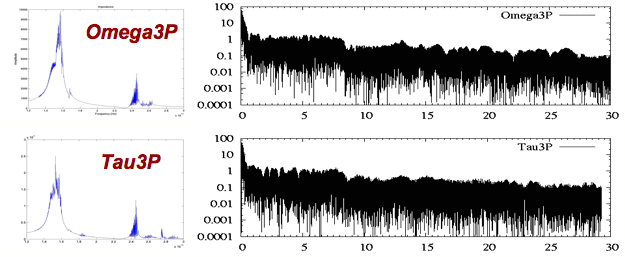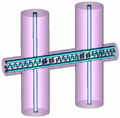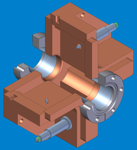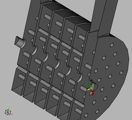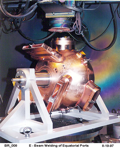| Panel | ||||||||||||
|---|---|---|---|---|---|---|---|---|---|---|---|---|
| ||||||||||||
|
Cell Design for Damped Detuned Structure (DDS) of the Next Linear Collider (NLC)
We used Omega3P to determine the dimensions for the 206 cells in the NLC Damped Detuned Structure. Each cell has 11 distinguished dimensions. The following is a picture of the cell manufactured according to the designed parameters. Microwave QC of the cells verified frequency accuracy of 1 part in 10,000 as targeted (the same as the machining tolerance). That would have led to potential savings of more than $100 millions in NLC machine cost because the DDS is 14% more efficient than the structure with standard cell designs.
| Wiki Markup |
|---|
{center:class=myclass}
!Omega3pAccompDDSCell.png! !DDSCellMeasurements.png!
{center} |
Heating Study for PEP-II Interaction Region
Omega3P was used to compute the trapped modes in the Interaction Region (IR) of the PEP-II. The calculated power distribution on the vacuum chamber walls provided insights for an improved design of the PEP-II IR. The following is the field distribution of a mode in the IR.
| Wiki Markup |
|---|
{center:class=myclass}
!Omega3pAccompPEPIIIR.png|align=center!
{center} |
The total power distribution in the IR is shown on the left. The upgrade of the IR resulted in 15% increase in the beam current, leading to higher luminosity and enabling new physics discovery. The right picture was the signature of the new particle found soon after the IR upgrade.
| Wiki Markup |
|---|
{center:class=myclass}
!PEPIIIRPowerDist.png! !NewParticle.png!
{center} |
Wakefield Computation for the NLC H60VG3 DDS
The Damped Detuned Structure (DDS) for the Next Linear Collider (NLC) was designed to provide 14% more efficiency. The following is the computer model of the H60VG3 DDS used for wakefield computations.
Using Omega3P by summing over the eigenmodes, the long-range wakefield in the entire 55-cell structure was evaluated. The wakefield agrees well with that obtained by direct simulation of driving a beam in the structure using the time-domain code Tau3P. The following shows the mode spectrum (left) and its summed wakefield (right). It was the first-ever direct wakefield calculation of the DDS and demonstrated the suppression of wakefield at long distances.
Wall loss Q for RIA RFQ
Omega3P was used to model RIA's low energy RFQ. Usind Adaptive Meshing Refinement(AMR) techniques, the accuracies in frequency and wall loss calculations improved by a factor of 10 and 2 respectively, while the CPU time used was a fraction of that without AMR. The improved accuracy of determining the frequency and Q would reduce the number of tuners and tuning range, and thus allowing a better design of the cooling system. Subsequently, this would lead to significant cost saving.
LCLS RF Gun Design
The following is a picture of the LCLS RF gun successfully commissioned in early 2007.
| Wiki Markup |
|---|
{center:class=myclass}
!Omega3pAccompLCLSRFgun.png|width=300!!357px-RFGunQuad.png!
{center} |
Using higher-order basis functions in Omega3P, the dimensions of the gun cavity were accurately determined for fabrication of the above prototype which satisfied the following important design requirements:
- mimized dipole and quadrupole fields via a racetrack dual-feed coupler design,
- reduced pulse heating by rounding of the z-coupling iris.

